Sustainability, Sociocultural Challenges, and New Power of Capitalism for Renewable Energy Megaprojects in an Indigenous Mayan Community of Mexico
Abstract
1. Introduction
“Sustainable development is development that meets the needs of the present without compromising the ability of future generations to meet their own needs. It contains, within it, two key concepts:
- 1.
- 2.
2. Research Techniques and Methodological Framework
3. Mayan Communities: New Territory for Investments in Solar Energy
- 1.
- DOMINATION STRUCTURE:
“This project does not care about our community; unfairly, it ended up unbalancing us more than we already were. The company and the government contacted the most capitalist person in this community, Don Salomón, who made his fortune grow due to the work of the community. We have all worked for him and to grow his capital. Most of the houses belong to him. We only own the ejidos that the government gave us through agrarian reform and ended the era of green gold. The henequen was not only a source of income and did not only give work to families, but it was also something that ensured that we would continue having income; even though it was little, it was permanent.” “In my opinion, with the arrival of the unjust project, they tried to deceive us with Don Salomón, who gave us a few pennies to accept, because nobody wants to work in the forest, and for most of the young people who travel outside the city, the Edjidal land is far away. Most of the ejidatarios need this income from the offer of the purchase of the land and, in addition to the purchase, from working on it. After a while, we realized that Don Salomón did all that to be the sole owner of the ejido rental project with the company, and also the sole owner of the land and houses where we have lived since we can remember. He wants to be the sole owner of the company, with which he caused more than a conflict between ejidatarios, but also problems among the inhabitants of the community.”
- 2.
- PERMANENT NEGOTIATION:
“This project came here that way because we lack a lot, and when entering in that way, they knew that it could be done because most of the ejidatarios do not have a decent income. The milpa is over and they are old; everyone thinks that any penny will be welcome,” said one ejidatario who is against the project. “This solar park came that way because we, as a community, are no longer a single hand; just seeing that the politicians and the ejidatarios were in the context, as well as the women and people of the community, whenever there is more money, there will be more demand. The damage was already done; it only located us,” said another ejidatario. “In general, the context of the project must be understood because the contact was made with the only person in the city who gave jobs. It is only necessary to clarify that there is a difference in the sale of land so that it has one use and when it is suddenly given another use. It can be said that the project reached people in disguise and invisibly.”
4. Results and Discussion
4.1. Energy Transition between New Power and the Liminalities of Sustainability and Energy Democracy
4.1.1. Political–Economic Power of the Company and the Government: An Example of Unethical Power
“Well, here we think differently, as we have always come to accept what is offered, especially from the government; almost nobody got upset. It did not take long until the presale. Everyone now says it was out of necessity, but still, because there is plenty of trust in the government, we have also had the habit of acting and less that of asking” (field, 2019–2020).
“Here, money is always a blessing with what they come to offer us because the people here need it, but we did not doubt until that day we went up; even both of them had doubts about why Don Salomón would want to buy the entire ejido” (field, 2019–2020).
“Here, about the authorities, no one could understand their role; they seek to balance between us and the company, up to where they defend us. I really cannot confirm it, but they did try to bring that to a successful conclusion because I said yes” (field, 2019–2020).
“Here, nobody will tell me how and to what extent the authorities are in favor of the company. If everyone who has money becomes a subordinate, it is because it suits them, as do their strategies of calming down and being part of the protocol with the effort to talk to and invite the community. After all, the bites were not lacking; even I said that the first business was going to leave us with nothing. I was supported by the former commissioner; the current one did not respond. He tried to be gentle, but they are the same, liars and corrupt.”
4.1.2. Ejido and Community: A New Alternative Sociocultural Power with Limits
“Listening to what the company mentioned on this day, we did not have to wait another minute, as we had made the decision to paralyze Don Salomón and to recover our ejido land. It was the day to end everything; not only to cancel the sale of the land, but also to start a new negotiation with the company until achieving what can be called an achievement today” (field, 2019–2020).
“We really must recognize the work done by the ejido. We not only have to recover the ejido land that we were going to lose, but also come to have equal power. The event that happened has made us work again as a community to fight for our rights” (field, 2019–2020).
“From this day on, the ejido feels value; unlike before, we will understand that the land is worth more than we have thought, and if we protested against Don Salomón, it is because we did not agree with what he had as a plan, so to fight him well, the ejidatarios did the right thing” (field, 2019–2020).
“Here in San José Tipceh, yes, we came to fight for the ejido, which, in the end, didn’t go to a complete sale. That is why we are always at the forefront; we are not going to lower our level. Those lands that are for urban expansion of the community, where we all have rights, from time to time, they kept telling us that they belong to Don Salomòn. We are not Don Salomòn; here, we continue struggling against the company and everyone. Even the authorities are satisfied with what little is given to them, so for us, the fight is not over. We would have to go to Panama and to contact academics and international foundations to know our rights and our power. We will be the strongest so that our lands are respected” (field, 2019–2020).
“Of course, no one can deny that the company assumed the loss of the money that we have not returned to Don Salomón. They offered us more than they were planning to give to him. They tried to offer us even more than they intended. That is, our pressure turned out to be powerful, forcing even the authorities to submit to what we thought. That, of course, was the first time we have lived as ejido and people. I still keep asking how long and if they gave us what we asked for. I even got to hear that the company is leaving, and I hoped that it would be true” (field, 2019–2020).
“The company returned the money to Don Salomón, to whom nobody wanted to return. Besides, the company gave us a courtesy while initiating the contract, but as the first contract was signed, 4,000 pesos were given to each person as an expenditure for the signature.”
“In the case of the company, they always tried to open negotiations and tried to understand our version without letting us understand that we are fighting because they lean towards the government. They are the people of the government, along with other authorities, who validate the environmental impacts and risk assessments and issue permits.”
4.1.3. Sociocultural Limitations for Sustainability and Absence of Energy Democracy
“No one cared about being indigenous or not until the conflict grew, and then everyone took refuge in being Mayan, even the young people who live by working in Cancun” (field, 2019–2020).
“I don’t expect any offer here. In that community, they only want to end the indigenous, the local, the original, but they also do not want anyone to remain Mayan. With their projects, they plan to end us; instead, nobody defends us” (field, 2019–2020).
“Here, in the case of San José, the reactions we had as a town, community, and ejido had a source. We did not do that emptily; we had reason to stop the sale. After hearing what the company said, we could not stop, even that is not above this group that is against it, who continue to fight due to their vision of where that bad weather takes us” (field, 2019–2020).
“I want to be honest with myself. Don Salomón did not pay us to accept and to sell the land; that’s why when we knew what was going to happen, and thank God I went with time, we came to paralyze the presale where we had not only one chance, but several occasions to negotiate with the company” (field, 2019–2020).
“Here, it was not a created process that we sought to fight. It was since Don Salomón deceived us and upon learning that from the voice of the company, that, in the end, what he bought from us was rented. Our fight was not to leave that injustice against him, and afterwards against the same company, until negotiating what today, as a majority, we have signed with the presence of the government” (field, 2019–2020).
“Here, everything that the community did was right; it does not seem to me that they were right in that this group continues with their ideas, against which we have signed” (field, 2019–2020).
“We got to do everything, fight, shout, press, negotiate, see for our economy, as a rural, indigenous community, that this territory belongs to us, and we can negotiate for it because, according to me, that which was necessary was done. The case of San José is already known; I do not need to speak, it is registered in any social network or newspaper page” (field, 2019–2020).
“We can understand that the resistance was not stable. At all times, there is talk of some dynamics. It was contextual, but many times they said that the resistance did not have a balanced voice and that it was the same group that negotiated, demanding as a representative of the community, but in several consultations and assemblies, almost the same person and the same speech were spoken of, which sometimes led to lawsuits and disputes that could have been avoided” (field, 2019–2020).
“Here, it was not easy to heal the wound from the beginning, but the authorities insisted that we continue to listen, above all, to the version of the same company. Here, the matter was discussed a lot. We were worried about if the company got fed up and the project was cancelled. I don’t know how we are now that many of us have found work during the six months in which we cleaned the land; we have been collecting the rent for almost two years because, in the end, it still helps, but now we have sued the company and even SENER (Spanish abbreviation of Secretariat of Energy)” (field, 2019–2020).
4.2. Sustainability and Gender Discrimination
5. Conclusions and Recommendations
Author Contributions
Funding
Acknowledgments
Conflicts of Interest
Appendix A
References
- UNEP. Decoupling Natural Resource Use and Environmental Impacts from Economic Growth; United Nations: New York, NY, USA, 2011; ISBN 9789280731675. [Google Scholar]
- Brundtland, G.H. Our common future; Oxford University Press: Oxford, UK, 1987. [Google Scholar] [CrossRef]
- Zander, P.; Kächele, H. Modelling multiple objectives of land use for sustainable development. Agric. Syst. 1999, 59, 311–325. [Google Scholar] [CrossRef]
- United Nations. Transforming our world: The 2030 agenda for sustainable development. United Nations sustainable knowledge platform. Sustain. Dev. Goals 2015. Available online: https://sustainabledevelopment.un.org/post2015/transformingourworld (accessed on 2 May 2020).
- Penadés-Plà, V.; Martínez-Muñoz, D.; García-Segura, T.; Navarro, I.J.; Yepes, V. Environmental and social impact assessment of optimized post-tensioned concrete road bridges. Sustainability 2020, 12, 4265. [Google Scholar] [CrossRef]
- Tariq, R.; Sheikh, N.A.; Xamán, J.; Bassam, A. An innovative air saturator for humidification-dehumidification desalination application. Appl. Energy 2018, 228, 789–807. [Google Scholar] [CrossRef]
- Tariq, R.; Sohani, A.; Xamán, J.; Sayyaadi, H.; Bassam, A.; Tzuc, O.M. Multi-objective optimization for the best possible thermal, electrical and overall energy performance of a novel perforated-type regenerative evaporative humidifier. Energy Convers. Manag. 2019, 198, 111802. [Google Scholar] [CrossRef]
- Arana Landin, S. Social economy as the means to help achieve the targets of sustainable development goal 14. Sustainability 2020, 12, 4529. [Google Scholar] [CrossRef]
- United Natioms. UNCED Earth Summit Agenda 21: The United Nations programme of action from Rio; CreateSpace: Lexington, KY, USA, 1992. [Google Scholar] [CrossRef]
- United Nations Sustainable Development Goals: Sustainable Development Knowledge Platform. 2019. Available online: sustainabledevelopment.un.org (accessed on 2 May 2020).
- Rojas Quiñónez, C.M. Evolución de las Características y de los Principios del Derecho Internacional Ambiental y su Aplicación en Colombia—Derecho del Medio Ambiente, 1st ed.; Universidad Externado de Colombia: Bogotá, Colombia, 2004; ISBN 958-616-802-6. (In Spanish) [Google Scholar]
- Alsayegh, M.F.; Abdul Rahman, R.; Homayoun, S. Corporate economic, environmental, and social sustainability performance transformation through ESG disclosure. Sustainability 2020, 12, 3910. [Google Scholar] [CrossRef]
- Badia, F.; Bracci, E.; Tallaki, M. Quality and diffusion of social and sustainability reporting in Italian public utility companies. Sustainability 2020, 12, 4525. [Google Scholar] [CrossRef]
- Tariq, R.; Xamán, J.; Bassam, A.; Ricalde, L.J.; Soberanis, M.A.E. Multidimensional assessment of a photovoltaic air collector integrated phase changing material considering Mexican Climatic conditions. Energy 2020, 209, 118304. [Google Scholar] [CrossRef]
- Angel, J. Towards Energy Democracy: Discussions and Outcomes from an International Workshop. Available online: https://www.tni.org/en/publication/towards-energy-democracy (accessed on 2 May 2020).
- Fraune, C.; Knodt, M. Sustainable energy transformations in an age of populism, post-truth politics, and local resistance. Energy Res. Soc. Sci. 2018. [Google Scholar] [CrossRef]
- Hale, J.; Legun, K.; Campbell, H.; Carolan, M. Social sustainability indicators as performance. Geoforum 2019, 103, 47–55. [Google Scholar] [CrossRef]
- Phondani, P.C.; Maikhuri, R.K.; Rawat, L.S.; Negi, V.S. Assessing farmers’ perception on criteria and indicators for sustainable management of indigenous agroforestry systems in Uttarakhand, India. Environ. Sustain. Indic. 2020, 5, 100018. [Google Scholar] [CrossRef]
- Meadows, J.; Annandale, M.; Ota, L. Indigenous Peoples’ participation in sustainability standards for extractives. Land Use Policy 2019, 88, 104118. [Google Scholar] [CrossRef]
- Karanasios, K.; Parker, P. Tracking the transition to renewable electricity in remote indigenous communities in Canada. Energy Policy 2018, 118, 169–181. [Google Scholar] [CrossRef]
- Schwoerer, T.; Schmidt, J.I.; Holen, D. Predicting the food-energy nexus of wild food systems: Informing energy transitions for isolated indigenous communities. Ecol. Econ. 2020, 176, 106712. [Google Scholar] [CrossRef]
- Fernández-Llamazares, Á.; Virtanen, P.K. Game masters and Amazonian Indigenous views on sustainability. Curr. Opin. Environ. Sustain. 2020, 43, 21–27. [Google Scholar] [CrossRef]
- McEwan, C. Spatial processes and politics of renewable energy transition: Land, zones and frictions in South Africa. Political Geogr. 2017. [Google Scholar] [CrossRef]
- Morrice, E.; Colagiuri, R. Coal mining, social injustice and health: A universal conflict of power and priorities. Health Place 2013. [Google Scholar] [CrossRef]
- Bedi, H.P. “Lead the district into the light”: Solar energy infrastructure injustices in Kerala, India. Glob. Transit. 2019. [Google Scholar] [CrossRef]
- Grossmann, K. Using conflicts to uncover injustices in energy transitions: The case of social impacts of energy efficiency policies in the housing sector in Germany. Glob. Transit. 2019. [Google Scholar] [CrossRef]
- Andreas, J.J.; Burns, C.; Touza, J. Overcoming energy injustice? Bulgaria’s renewable energy transition in times of crisis. Energy Res. Soc. Sci. 2018. [Google Scholar] [CrossRef]
- Mueller, J.T.; Brooks, M.M. Burdened by renewable energy? A multi-scalar analysis of distributional justice and wind energy in the United States. Energy Res. Soc. Sci. 2020. [Google Scholar] [CrossRef]
- The Lancet Planetary Health. Environmental racism: Time to tackle social injustice. Lancet Planet. Health 2018, 2, e462. [Google Scholar] [CrossRef]
- Martinez, N. Resisting renewables: The energy epistemics of social opposition in Mexico. Energy Res. Soc. Sci. 2020, 70, 101632. [Google Scholar] [CrossRef]
- Yuan, X.; Zuo, J.; Huisingh, D. Social acceptance of wind power: A case study of Shandong Province, China. J. Clean. Prod. 2015. [Google Scholar] [CrossRef]
- Batel, S. Research on the social acceptance of renewable energy technologies: Past, present and future. Energy Res. Soc. Sci. 2020, 68, 101544. [Google Scholar] [CrossRef]
- Behrsin, I. Controversies of justice, scale, and siting: The uneven discourse of renewability in Austrian waste-to-energy development. Energy Res. Soc. Sci. 2020. [Google Scholar] [CrossRef]
- Samarakoon, S. The troubled path to ending darkness: Energy injustice encounters in Malawi’s off-grid solar market. Energy Res. Soc. Sci. 2020, 69, 101712. [Google Scholar] [CrossRef]
- Cordoves-Sánchez, M.; Vallejos-Romero, A. Social construction of risk in non-conventional renewable energy: Risk perception as a function of ecosystem services in La Araucanía, Chile. Ecol. Econ. 2019, 159, 261–270. [Google Scholar] [CrossRef]
- Velasco-Herrejon, P.; Bauwens, T. Energy justice from the bottom up: A capability approach to community acceptance of wind energy in Mexico. Energy Res. Soc. Sci. 2020, 70, 101711. [Google Scholar] [CrossRef]
- Carbajo, R.; Cabeza, L.F. Sustainability and social justice dimension indicators for applied renewable energy research: A responsible approach proposal. Appl. Energy 2019, 252, 113429. [Google Scholar] [CrossRef]
- Fobissie, E.N.; Inc, F. The role of environmental values and political ideology on public support for renewable energy policy in Ottawa, Canada. Energy Policy 2019, 134, 110918. [Google Scholar] [CrossRef]
- Zárate-Toledo, E.; Patiño, R.; Fraga, J. Justice, social exclusion and indigenous opposition: A case study of wind energy development on the Isthmus of Tehuantepec, Mexico. Energy Res. Soc. Sci. 2019. [Google Scholar] [CrossRef]
- Mejía-Montero, A.; Alonso-Serna, L.; Altamirano-Allende, C. The role of social resistance in shaping energy transition policy in Mexico: The case of wind power in Oaxaca. In The Regulation and Policy of Latin American Energy Transitions; Elsevier: Amsterdam, The Netherlands, 2020; pp. 303–318. [Google Scholar]
- Scott, J.C. The Moral Economy of the Peasant: Rebellion and Subsistence in Southeast Asia on JSTOR. Available online: https://www.jstor.org/stable/j.ctt1bh4cdk (accessed on 4 July 2020).
- Montilla, L.E. Reseña: Resistir al Poder; Universidad Autónoma de Bucaramanga: Bucaramanga, Colombia, 2002. [Google Scholar]
- Scott, J.C. Weapons of the Weak: Everyday Forms of Peasant Resistance on JSTOR. Available online: https://www.jstor.org/stable/j.ctt1nq836 (accessed on 4 July 2020).
- Giddens, A. The constitution of society: Outline of the theory of structuration: Elements of the theory of structuration. In Practicing History: New Directions in Historical Writing after the Linguistic Turn; Routledge: London, UK, 2004; ISBN 9780203335697. [Google Scholar]
- Adams, R. La ética y el antropólogo social en América Latina. Am. Behav. Sci. 1967, 10, 16–21. (In Spanish) [Google Scholar] [CrossRef]
- Foucault, M. Del poder de soberanía al poder sobre la vida. In Geneaología del Racismo (Original Title: Il faut Défendre la Société); Editorial Altamira: Plata, Argentina, 1976; ISBN 987-9017-01-3. Available online: https://www.exapuni.com/carreras/apunteHash/4be06ad644d2fc68575267cd2bce99cc (accessed on 1 September 2020). (In Spanish)
- Foucault, M. Undécima lección. In Geneaología del Racismo (Original Title: Ilfaut Défendre la Société); Editorial Altamira: La Plata, Argentina, 2006; ISBN 9879017013. Available online: https://www.academia.edu/34719954/Foucault_Michel_GENEALOG%C3%8DA_DEL_RACISMO_pdf (accessed on 1 September 2020). (In Spanish)
- Foucault, M. Un Diálogo Sobre el Poder y Otras Conversaciones, 7th ed.; El libro de Bolsillo Alianza Editorial: Madrid, Spain, 2000; Available online: https://museo-etnografico.com/pdf/puntodefuga/181003focault2.pdf (accessed on 1 September 2020). (In Spanish)
- Ortner, S.B. Resistance and the Problem of Ethnographic Refusal. Comp. Stud. Soc. Hist. 1995, 37, 173–193. [Google Scholar] [CrossRef]
- Burt, B.; Keesing, R.M. Custom and confrontation: The Kwaio struggle for cultural autonomy. Man 1994. [Google Scholar] [CrossRef]
- Lévy, B.-H. Foucault: No al Sexo Rey. 1977. Available online: https://gredos.usal.es/handle/10366/66655 (accessed on 1 September 2020). (In Spanish).
- Fernández-Kelly, P. Reforming Gender: The effects of economic change on masculinity and femininity in Mexico and the US. Women Stud. Rev. 2005, 69–101. Available online: https://lcw.lehman.edu/academics/inter/women-studies/documents/reforming-gender.pdf (accessed on 1 September 2020).
- Baños Ramírez, O. Yucatán: Ejidos Sin Campesinos; Estudios Sociológicos de El Colegio de México; Universidad Autónoma de Yucatán: Mérida, Yucatán, Mexico, 1989; Available online: https://estudiossociologicos.colmex.mx/index.php/es/article/view/1105 (accessed on 21 June 2020).
- Eckstein, S. El Ejido Colectivo en México, 1st ed.; Fondo de Cultura Económica: Distrito Federal, Mexico, 1966. [Google Scholar]

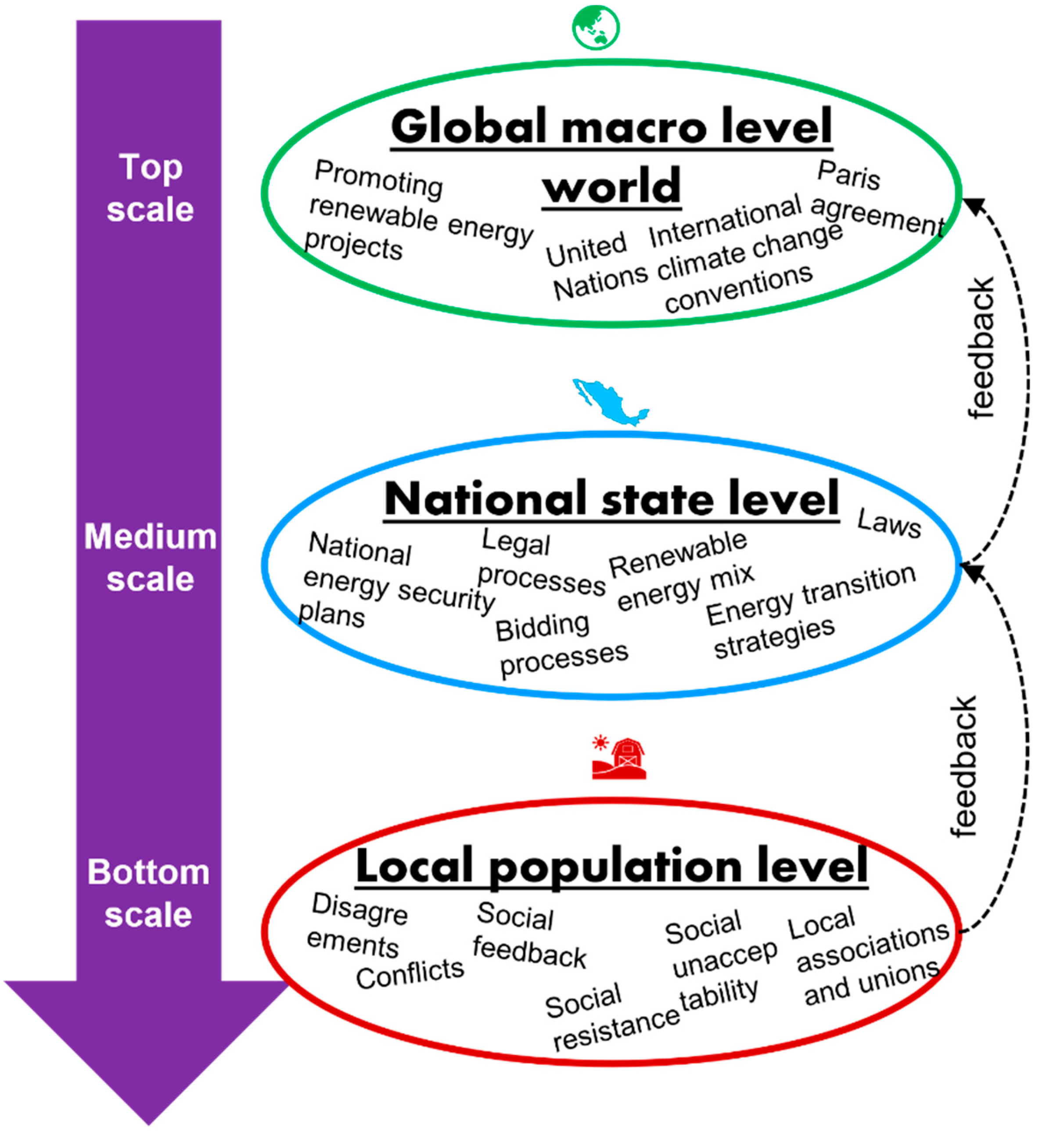
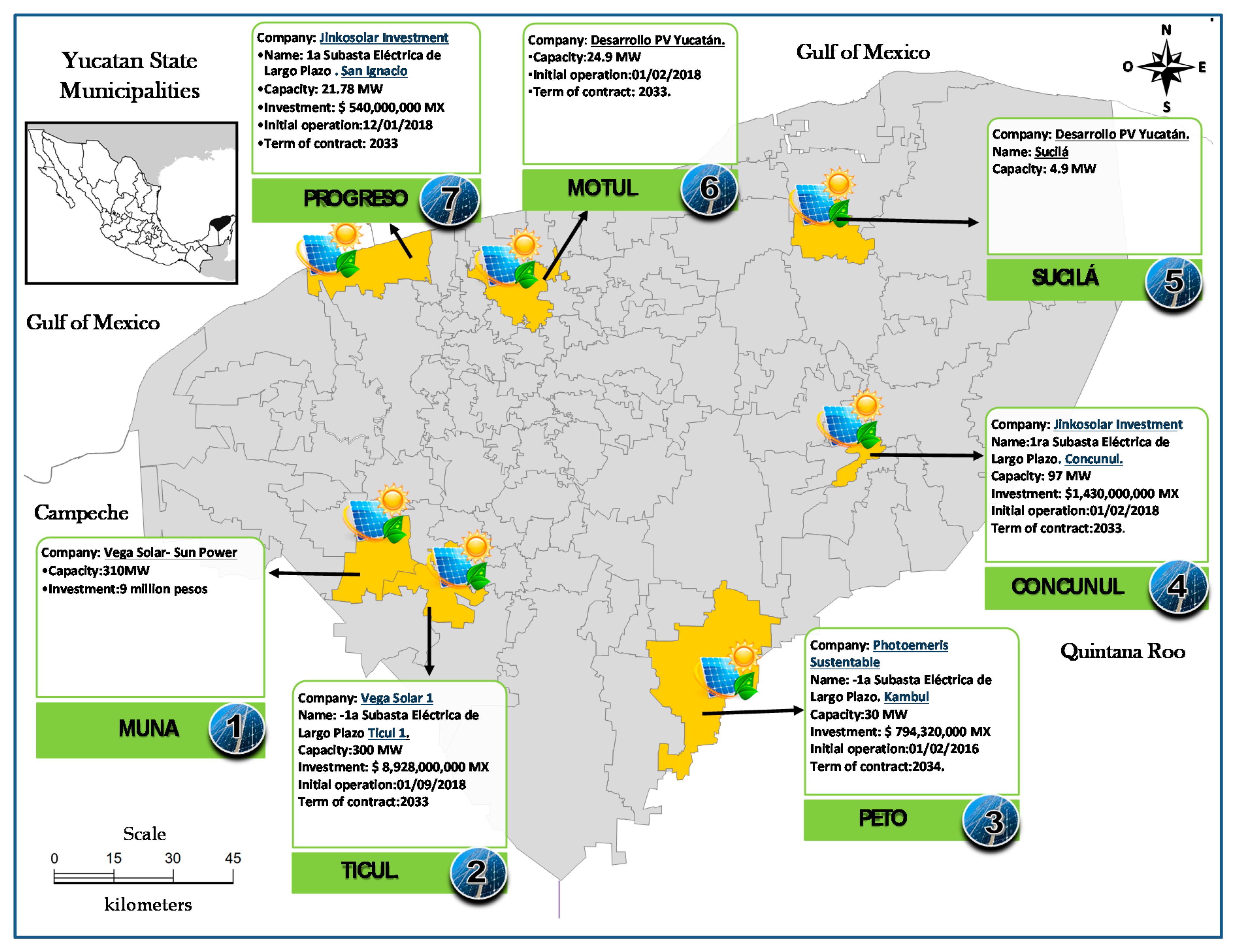
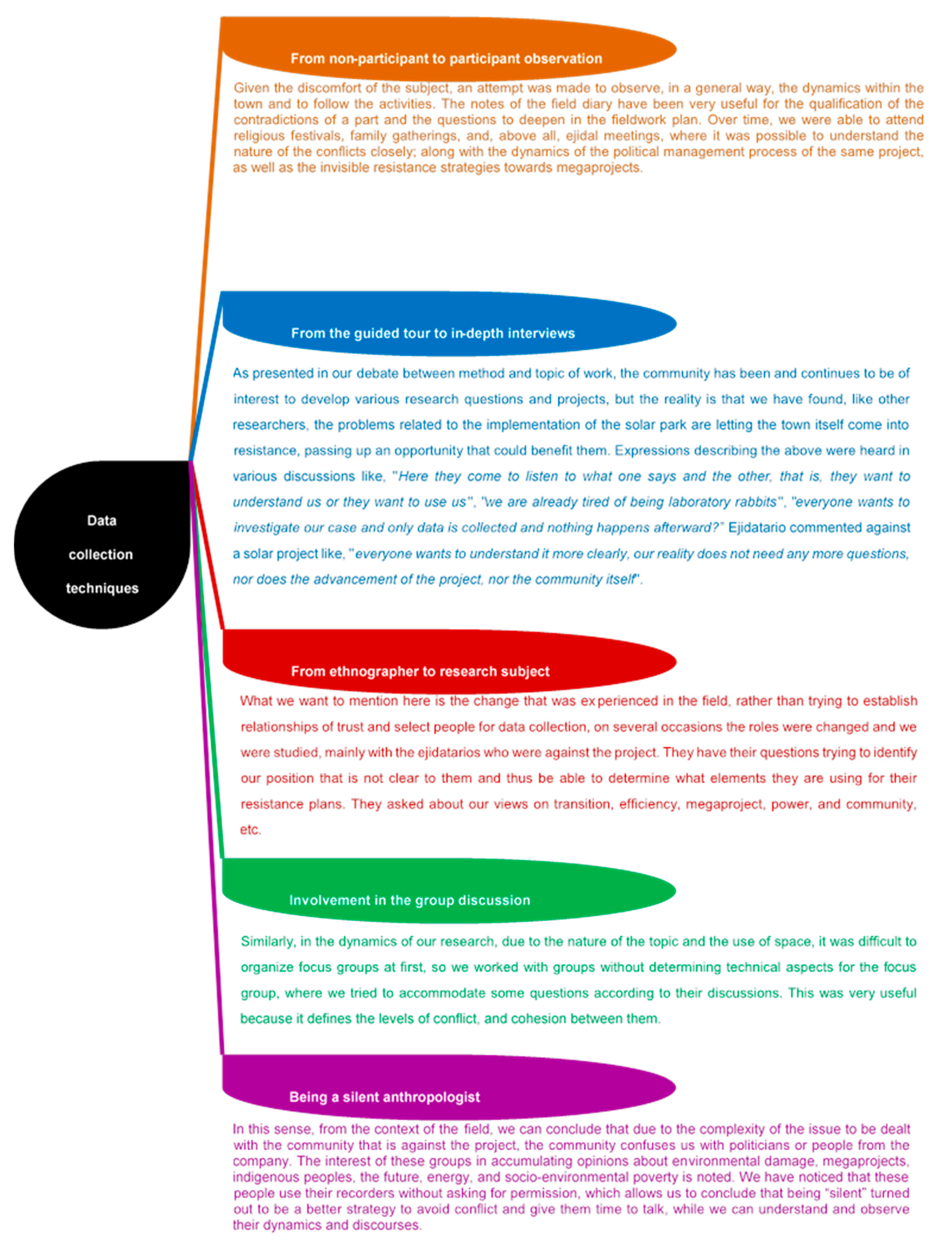
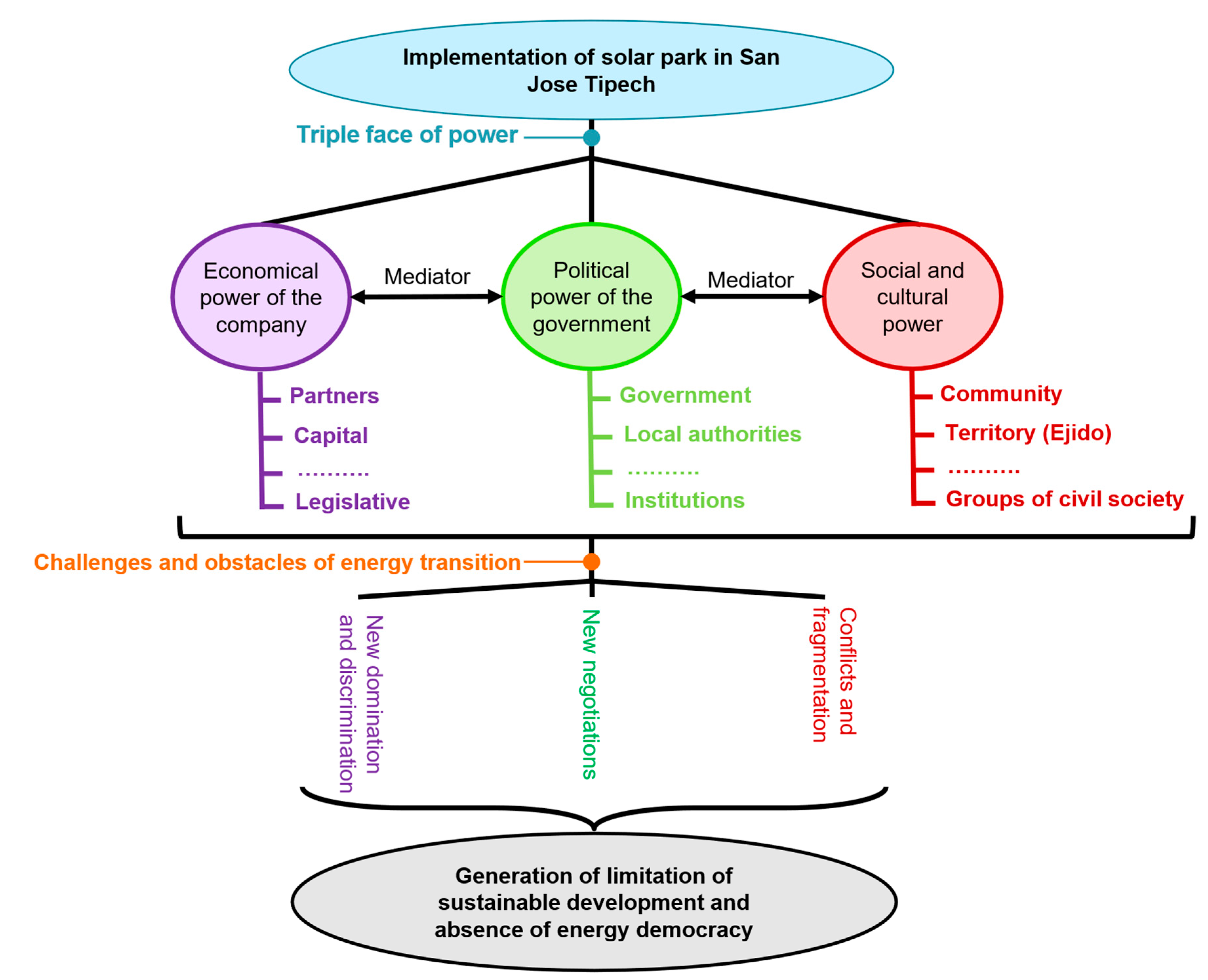
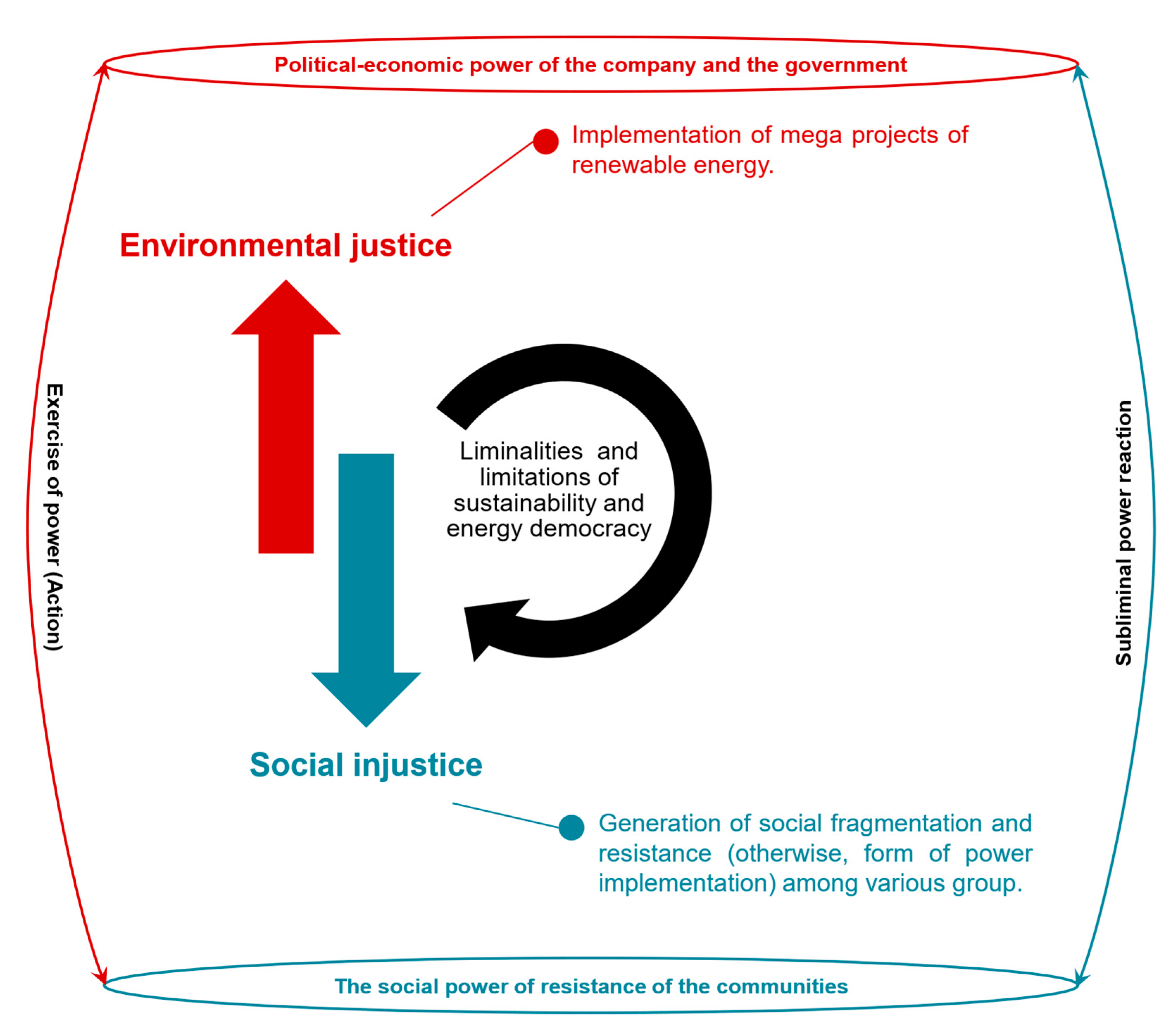
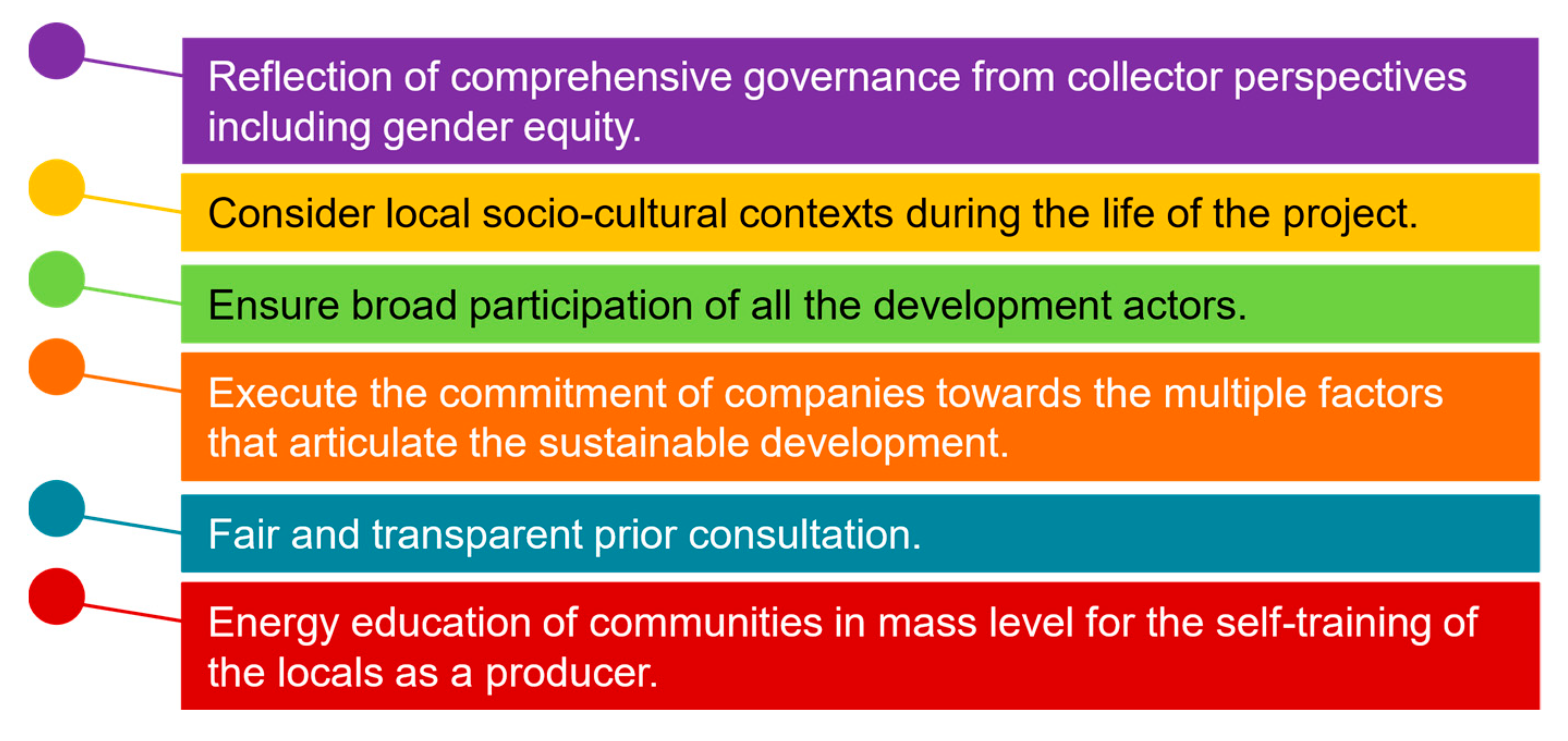
| Reference | Summary |
|---|---|
| [23] | This work presents a case of South Africa to understand the renewable energy transition and mentioned that it is a simultaneously spatial and political injustice. The authors argued that energy transitions are intrinsically bound up with both the materiality and the historical and contemporary politics of land. |
| [24] | This article combines the theoretical base for defining the social, environmental, and health injustices of the coal industry among the local communities. The authors pointed out that the injustices, conflicting priorities, and power asymmetries are a triangular problem between the industry, government, and inhabitants of mining communities. |
| [25] | The energy transition of India increasingly prioritizes solar energy infrastructure to meet global sustainability goals, but this infrastructure requires an enormous land area. The authors presented the case of the solar infrastructure of Kerala, which is associated with social injustice. It is recommended to consider the local context while addressing the energy transition. |
| [26] | The authors have analyzed the energy efficiency policies in housing and mentioned that fostering the energy efficiency improvements has led to rising protests and conflicts because investments made in retrofitting became a means of speculation and displacement of low-income residents. The authors have used the social conflict theory to interpret the different forms of conflicts in the case of Germany. It is also discussed that the state has implemented energy standards for buildings without considering the socio-economic status of residents and has generated a conflict between the housing companies and tenants. |
| [27] | This paper explores the drivers and implications of Bulgaria’s renewables expansion to assess general expectations of influential factors shaping renewable energy transitions in the context of poor states. |
| [28] | The authors used data from the American Community Survey, U.S. Wind Turbine Database, and the National Renewable Energy Lab, and outlined the current landscape of wind energy injustice along social dimensions. |
| [29] | Editorial note from The Lancet Planetary Health has mentioned that environmental racism shows that environmental and social issues cannot be neatly separated from each other and concluded that environmental protection policies must not be considered individually, and the individuals most affected by them should be considered as much as the average population. |
| [30] | Emphasis is given that social research should be fundamental in the planification of the energy transition of Mexico through examples of the implementation of renewable energy projects that caused social opposition and conflicts in indigenous communities. |
| [31] | A case study is presented to evaluate the social acceptance of wind energy power in Shandong Province, China. It was concluded that residents may accept renewable energy due to their concerns about environmental issues. |
| [32] | Presented three approaches of the social science research of renewable energy projects; these are normative, criticism, and critical approaches. |
| [33] | The authors say that framing discrepancies between the policy elites and residents represents a reflection of procedural injustice. |
| [34] | The authors argued that solar products are celebrated as encouraging development, and there is a limited discourse about the consequences of relying on off-grid solar markets to address energy poverty. The authors presented a case study of Malawi to demonstrate how a poorly regulated solar market has generated injustice in the local settings. |
| [35] | Research was carried out based on a qualitative methodological framework, and it was concluded that conflicts around non-conventional renewable energy projects would be linked to a reduction of ecosystem service provision in the context of La Araucanía, Chile. |
| [36] | A case is presented through examples of wind energy projects in Southern Mexico. It was concluded by the authors that a bottom-up approach is recommended to understand the complex concepts of energy justice with the indigenous community. |
| [37] | The authors emphasized that sustainability and social justice deserve attention in the sustainable energy transition plans. |
| [38] | The authors highlighted that, when it is aligned with environmental problems, political ideology determines the public support only. The authors emphasized that Ontario, Canada needs more effort to increase the level of public support while encouraging the use of renewable energies. |
© 2020 by the authors. Licensee MDPI, Basel, Switzerland. This article is an open access article distributed under the terms and conditions of the Creative Commons Attribution (CC BY) license (http://creativecommons.org/licenses/by/4.0/).
Share and Cite
El Mekaoui, A.; Tariq, R.; Ramírez, O.B.; Méndez-Monroy, P.E. Sustainability, Sociocultural Challenges, and New Power of Capitalism for Renewable Energy Megaprojects in an Indigenous Mayan Community of Mexico. Sustainability 2020, 12, 7432. https://doi.org/10.3390/su12187432
El Mekaoui A, Tariq R, Ramírez OB, Méndez-Monroy PE. Sustainability, Sociocultural Challenges, and New Power of Capitalism for Renewable Energy Megaprojects in an Indigenous Mayan Community of Mexico. Sustainability. 2020; 12(18):7432. https://doi.org/10.3390/su12187432
Chicago/Turabian StyleEl Mekaoui, Amina, Rasikh Tariq, Othón Baños Ramírez, and P.E. Méndez-Monroy. 2020. "Sustainability, Sociocultural Challenges, and New Power of Capitalism for Renewable Energy Megaprojects in an Indigenous Mayan Community of Mexico" Sustainability 12, no. 18: 7432. https://doi.org/10.3390/su12187432
APA StyleEl Mekaoui, A., Tariq, R., Ramírez, O. B., & Méndez-Monroy, P. E. (2020). Sustainability, Sociocultural Challenges, and New Power of Capitalism for Renewable Energy Megaprojects in an Indigenous Mayan Community of Mexico. Sustainability, 12(18), 7432. https://doi.org/10.3390/su12187432





